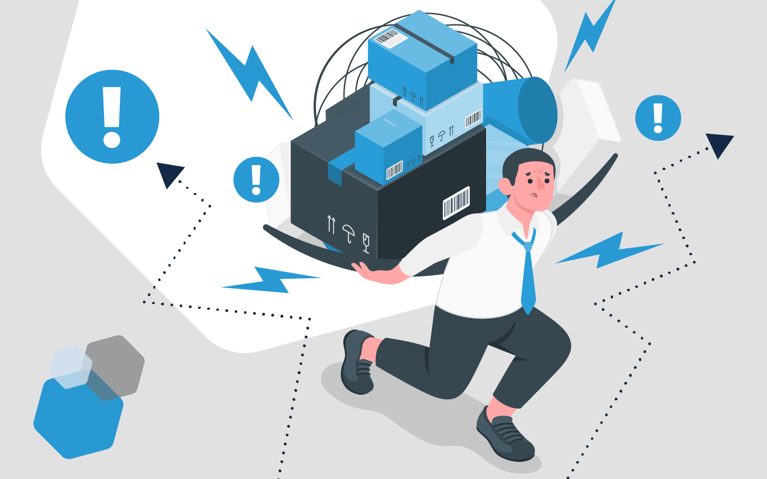Smartphones have seamlessly integrated into our daily lives. They serve countless purposes, from communicating and navigating to conducting research and self-organization. These small but mighty mobile devices allow people to book a trip, read up on current news or shop for a new wardrobe wherever they’re at. As of September 2023, 96 percent of Americans aged 18 to 29 years owned a smartphone – and on average, people spend 3 hours and 15 minutes on their smartphone each day.
Retailers have embraced the rise of the smartphone, using text messaging as another channel to communicate with and engage consumers. SMS (short message service, a form of text messaging) is a powerful tool that supports marketing, customer service and omnichannel fulfillment strategies. While email is still a valid tool and an important part of the customer experience, SMS sees high open and clickthrough rates, making it worthwhile for brands to adopt and utilize to further optimize the customer journey.
This article will cover how to use SMS throughout your ecommerce operations to enhance the customer experience.
How to use SMS for retail marketing
Once a consumer opts into SMS, you’ve created a connection. How you use that connection is crucial. Like any form of marketing, oversaturation can deter. However, in general, customers like the simplicity of a text. According to recent surveys, 85% of smartphone users prefer mobile messages to emails or calls, and 90% open text messages within three minutes. Brands have found that when done right, SMS is a tool that can drive engagement, loyalty and growth.
SMS marketing best practices
While SMS is an excellent tool, it’s critical to approach it strategically. Best practices are a good place to start:
- Only send texts to consumers who opt-in: Develop clear forms and opt-ins for SMS. Additionally, with the first text, have people confirm with a Yes or No that they are okay with receiving texts.
- Make it simple to opt out: A customer should be able to opt out of texts or even specific types of texts. For example, some companies end each text with the message, “Text STOP to unsubscribe.”
- Brand your texts: Your texts should remain consistent with your branding. Use language and visuals that are cohesive throughout your marketing channels.
- Keep messages short and sweet: Start with some personalization by adding the consumer’s name. Include your company name. From there, create content brief, to-the-point content that offers a strong call to action (CTA). Conclude your message with an opt-out option. Keep your messages within 160 characters.
- Develop an SMS strategy: Don’t randomly send messages when you feel like it – instead, look at it like any other marketing channel. Create a strategy for what, how often and when to send your messages. As you move forward with SMS, use analytics and customer feedback to find the right balance so you do under-or overwhelm the customer.
- Comply with regulations: Always follow privacy laws and SMS marketing regulations.
Types of retail SMS marketing
There are several ways to use SMS marketing in retail ecommerce fulfillment. Try:
- Welcoming with a discount: A brief message welcoming a new subscriber and offering an incentive is a great way to engage effectively.
- Announcing special events: You may have a sale coming up or an TikTok live shopping event. Let your subscribers know about upcoming events. SMS is also a great way to encourage loyalty. By offering exclusive access through text, you create a sense of urgency and FOMO (fear of missing out). These VIP messages also act as a reward.
- Showcasing new products: Announce a new line or product via text. It generates excitement and may even re-engage customers who haven’t shopped recently. It’s also an excellent way to drive traffic to your site.
- Sending back-in-stock notices: SMS can let customers know when a desired item is back in stock, or even send them recommendations for related products they might like instead.
- Following up on abandoned carts: Cart abandonment is a missed opportunity that happens all too frequently in the retail world. Use text to potentially recover a sale and even entice with a discount or free shipping.
SMS is an effective channel for promotions, alerts and customer engagement. The simplicity of SMS contributes to its effectiveness in reaching a wide audience and driving immediate action. Brands can effectively leverage SMS to enhance communication, build customer relationships and deliver impactful marketing campaigns.
How to use SMS for retail customer service
SMS is revolutionizing customer service with its quick and direct communication capabilities. As a convenient and familiar channel, it allows customers to seek assistance or information effortlessly. Businesses use SMS to provide instant support, addressing queries and concerns in real-time. With the widespread presence of mobile phones, SMS enables a seamless and accessible customer service experience, allowing individuals to engage with brands at their convenience. This channel not only enhances customer satisfaction but also streamlines communication, making it an indispensable tool for modern customer service strategies.
Ways to use SMS for customer service
Brands can use SMS for customer service by:
- Providing instant support: Use SMS for real-time customer support, allowing customers to initiate and receive assistance promptly.
- Sending FAQs and informational alerts: Share frequently asked questions, helpful tips or important updates via SMS to proactively address common queries.
- Asking for feedback and responses to surveys: Gather valuable customer feedback through SMS surveys, providing a convenient way for customers to share their opinions. You can also use text messages to encourage online reviews.
- Allowing two-way communication: Enable two-way communication via SMS, allowing customers to ask questions, provide feedback or engage in a dialogue with customer support.
- Helping with password resets and account information: Provide secure and convenient account-related services, such as password resets and account information, through SMS.
Leveraging SMS for customer service enhances communication efficiency, improves customer satisfaction and provides a convenient platform for resolving issues and delivering a seamless overall experience.
How to use SMS for retail omnichannel fulfillment
In the dynamic landscape of retail omnichannel fulfillment, SMS emerges as a versatile tool, bridging the gap between businesses and customers. By incorporating SMS, retailers can offer a seamless and responsive experience across various channels. From order updates to delivery confirmations, SMS provides a direct line of communication that enhances customer engagement and satisfaction. This real-time communication channel proves invaluable in keeping customers informed about their orders, improving transparency and trust in the fulfillment process. Leveraging SMS in retail omnichannel fulfillment not only streamlines operations but also contributes to building lasting customer relationships.
Ways to use SMS for fulfillment
Use SMS to streamline your fulfillment operations and optimize the post-purchase experience by giving customer the information they seek. You can use SMS for:
- Order confirmation: Send an immediate SMS to customers confirming their order, providing reassurance and acknowledgment.
- Shipping updates: Keep customers informed about the status of their shipments with SMS notifications at key fulfillment stages, such as dispatch, transit and delivery.
- Delivery alerts: Alert customers in advance with SMS notifications about the expected delivery time and date, ensuring they are prepared to receive their orders.
- Order pickup reminders: If offering in-store or curbside pickup options, use SMS to remind customers of their scheduled pickup times and provide necessary instructions.
- Returns and exchanges: Simplify the returns process by sending SMS instructions for initiating returns or exchanges, making it convenient for customers.
- Survey for feedback: After order fulfillment, send SMS surveys to gather feedback on the overall fulfillment experience, helping to identify areas for improvement.
- Customer support: Further optimize the post-purchase experience by allowing customers to easily reach out for support or inquiries related to their fulfillment experience through a dedicated SMS line, offering a direct and convenient communication channel.
Leveraging SMS for fulfillment enhances communication efficiency, reduces uncertainty, and contributes to an overall positive customer experience. By integrating SMS strategically into the fulfillment process, retailers can provide transparency, build trust and foster customer loyalty.
Optimize the customer experience with Cart.com
SMS is a retail marketing powerhouse due to its direct and immediate reach. With high open rates and quick engagement, SMS cuts through the digital noise, delivering personalized promotions, exclusive deals and order updates directly to customers' pockets. It fosters a direct and intimate connection, driving customer engagement, loyalty and boosting conversion rates. In the fast-paced retail landscape, SMS stands out as a reliable and effective channel for timely communication, enhancing the overall customer experience. To learn more about our unified commerce solutions, contact the team at Cart.com today.
Subscribe to our emails for the latest industry insights!
By entering your email, you agree to receive marketing emails from Cart.com






